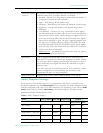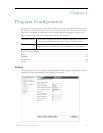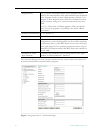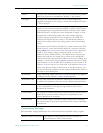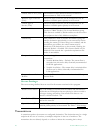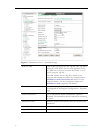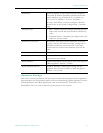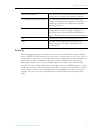
Program Configuration
VBrick H.264 Appliance Admin Guide 49
transmitting (in the case of multicast) and transmits if the client is reachable and listening (in
the case of unicast). The streams are transmitted across the network via the RTP protocol
encapsulated in UDP. You can configure up to 25 transmitters per program. Each transmitter
can be configured for video and/or audio and the video and audio have
separately-configurable destination ports. An "announce" can also be enabled for each
transmitter.
SDP and Announcements
Decoders require knowledge of the stream from an .sdp file before it can be decoded. Each
SDP description contains critical stream information such as profile, bit rate, addressing,
transmission methods, and content. The decoder (for example StreamPlayer or QuickTime)
will examine this file for all necessary configuration information relating to the stream. Upon
power-up and service interruption, the decoder will re-establish stream decoding by relating
back to information contained in the SDP file. SDP information may be requested via an
RTSP request made from the client to the server whereby the server responds with the same
information as contained in an SDP file. The SDP file may also be retrieved via an HTTP
server residing either on the VBrick or on an external HTTP server. The URL address for the
SDP file is based on the program and transmitter number, for example:
http://
AAA.BBB.CCC.DDD/vbStreamXdY.sdp
where: X is the program number, Y is the transmitter
number and AAA.BBB.CCC.DDD is appliance IP address.
For multicast applications, where the VBrick is operating in Transmitter Mode, the SDP
information is periodically broadcast to a pre-defined address via multicast announcements.
For unicast announcements, a server can be configured to embed an RTSP URL within an
announce message so a remote decoder can easily gain access to SDP information and
subsequently initiate a Unicast RTP session. In some cases an H.264 stream may be sent to a
third-party reflecting server which is not capable of emitting its own SDP announcements.
Transmitters and servers can be configured to provide announcements advertising the URL
of the reflected stream and/or required SDP information.
Note
• In a unicast environment, individual copies of the stream are sent from the source
to each configured destination. In multicast, the stream is sent from the source
only once and a network router will transmit the stream to multiple destinations.
• To avoid unnecessary network traffic, the transmitter will not send if the network
socket fails to connect (has ICMP errors). In addition, Unicast destinations have a
configurable Unicast ping option. See the Unicast Ping parameter on Program
Configuration > Programs page.



